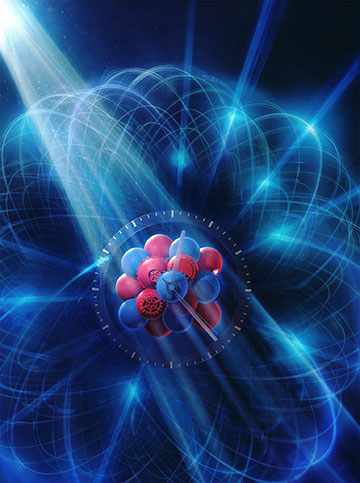
Scientists working on the European XFEL at DESY in Germany have excited and measured a very narrow transition in nuclei of scandium-45, a resonance that could one day be exploited in exceptionally accurate nuclear clocks. [Image: European XFEL/Helmholtz Institute Jena, Tobias Wüstefeld/Ralf Röhlsberger]
The world’s best clocks are already phenomenally accurate—losing or gaining the equivalent of just one second every 15 billion years. But new work from scientists in the United States and Europe raises the possibility that even more powerful timekeepers could remain accurate to the second for as long as 300 billion years.
The researchers used very bright and narrowband X-ray pulses from a free-electron laser to excite an exceptionally sharp transition in nuclei of scandium-45 (Nature, doi: 10.1038/s41586-023-06491-w). Although they have yet to measure the width of the transition itself, they reckon that their ability to fish out the associated decay products from a sea of background noise demonstrates the feasibility of what are known as nuclear clocks.
In search of accurate timekeeping
Atomic clocks involve locking an electromagnetic oscillator to a well-defined atomic transition by tuning its output over a narrow range of frequencies and establishing exactly where its radiation is absorbed by the atom. Clocks that feature a higher frequency transition for a given bandwidth have a higher quality factor—a superior precision that enables more stable ticking and also makes it easier to eliminate the systematic errors that limit accuracy.
Timekeeping has seen dramatic improvements in recent years thanks to the development of optical clocks, which operate at frequencies some six orders of magnitude higher than the microwave devices that serve as the world’s primary time standards. The most advanced optical clocks feature instabilities and uncertainties of around 1 part in 1018.
Nuclear clocks stand to go beyond even this by employing still higher frequency transitions in the ultraviolet or X-ray regions of the spectrum. They would also be more immune to electric and magnetic disturbances than atomic clocks, suggesting higher accuracies and potentially enabling the use of ensembles of oscillating nuclei inside bulk solids, which would further boost stability. However, the ability to generate useful fluxes of X-ray photons across the very narrow spectral ranges needed to probe such transitions has only become possible in recent years, with the advent of X-ray free-electron lasers (XFELs).
Measuring the transition
The focus of the latest work is a transition in scandium-45 that has an energy of 12.4 kiloelectronvolts (keV) and a lifetime of almost half a second—a near eternity in nuclear systems. With a linewidth of just 1.4 x 10-15 eV, the transition can in principle be nailed down to 1 part in 1019, which is four orders of magnitude better than the atomic strontium transitions used in many optical clocks.
Nuclear clocks stand to go beyond even [optical clocks] by employing still higher frequency transitions in the ultraviolet or X-ray regions of the spectrum.
Unfortunately, however, the very narrowness of the transition makes it extraordinarily hard to access. Modern X-ray sources typically have frequency spreads some 1015 times as broad, meaning that the vast majority of incoming energy will end up as background noise rather than being used to excite the scandium nuclei.
Tomasz Kolodziej, SOLARIS National Synchrotron Radiation Centre, Poland; Yuri Shvyd’ko, Argonne National Laboratory, USA and colleagues found that they could overcome this problem by carrying out careful measurements using the European XFEL at the Deutsches Elektronen-Synchrotron (DESY) laboratory in Hamburg, Germany. This 3.4-km-long machine generates very bright, spectrally well-defined X-ray pulses some 27,000 times per second.
The researchers directed the pulses at thin foils of scandium, then used a pair of solid-state detectors to pick up the (slightly lower-energy) X-rays given off when excited nuclei ejected electrons from the atomic orbitals around them and other electrons dropped down to fill their place. The challenge was picking out these faint signals from the vastly more numerous incoming X-ray photons. They didn’t know the exact transition energy ahead of time, so they had to scan the pulse energy over quite a wide range of +/− 50 eV. That meant bombarding the target with 1020 near-resonant photons, while detecting a mere 93 nuclear decays.
Toward a nuclear clock
To overcome such overwhelming odds, Kolodziej and colleagues took advantage of the slight delay between nuclear excitation and photon emission to move the target out of the XFEL beamline before making a measurement. They also discriminated between the input and output X-rays on the basis of energy, arrival time and polarization.
The researchers are confident that their results will have an impact on timekeeping—they foresee “the development of a scandium-45–based nuclear clock in the future”—as well as on spectroscopy and metrology.
By minimizing the background in this way, they were able to plot the detector count by incident energy and clearly distinguish a peak in the graph. They pinned this down to 12,389.59 eV, with an uncertainty over two orders of magnitude smaller than previous measurements.
The researchers are confident that their results will have an impact on timekeeping—they foresee “the development of a scandium-45–based nuclear clock in the future”—as well as on spectroscopy and metrology. But they acknowledge that plenty more work needs to be done. In particular, they first need to measure the transition’s true linewidth. Because they detected radiation from atomic rather than nuclear-generated electrons, which is incoherent, the width of the peak they measured was broadened by the incident X-rays’ energy spread.
The solution, they say, is to carry out time-resolved measurements of 12.4-keV X-rays that are coherently scattered off the scandium nuclei in a forward direction. This, they add, will involve taking a number of extra experimental steps, such as cooling down the target and also making it thicker to maximize the scattering signal.
